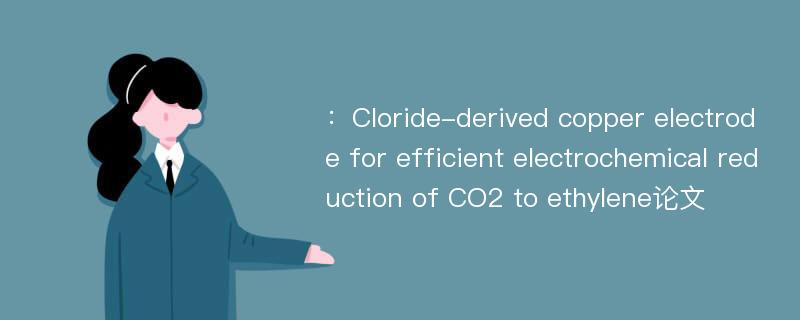
本文主要研究内容
作者(2019)在《Cloride-derived copper electrode for efficient electrochemical reduction of CO2 to ethylene》一文中研究指出:The electrochemical reduction of carbon dioxide can convert the greenhouse gas into value-added chemical products or fuels, which provides a promising strategy to address current energy and environmental issues. Increasing the selectivity for C2&C2+ products, particularly ethylene, remains an important goal in this field. We chose cuprous chloride as the catalyst precursor for electrochemical reduction of CO2, which efficiently converted carbon dioxide to ethylene. CuCl powder exhibited a maximum ethylene faradaic efficiency (FE) of 37%,ethylene partial current density of 14.8 mA/cm2, and selectivity of 57.5% for C2&C2+ products at-1.06 V (vs. reversible hydrogen electrode, RHE). Electron microcopy (TEM, SEM) and time-resolved ex situ X-ray diffraction (XRD) demonstrated that the catalyst was transformed gradually into a mixed phase of copper and cuprous oxide, with the morphological change into a cubic structure during reduction process. The presence of Cu1+ and the unique electrode morphology may simultaneously lead to the enhanced electrochemical activity.
Abstract
The electrochemical reduction of carbon dioxide can convert the greenhouse gas into value-added chemical products or fuels, which provides a promising strategy to address current energy and environmental issues. Increasing the selectivity for C2&C2+ products, particularly ethylene, remains an important goal in this field. We chose cuprous chloride as the catalyst precursor for electrochemical reduction of CO2, which efficiently converted carbon dioxide to ethylene. CuCl powder exhibited a maximum ethylene faradaic efficiency (FE) of 37%,ethylene partial current density of 14.8 mA/cm2, and selectivity of 57.5% for C2&C2+ products at-1.06 V (vs. reversible hydrogen electrode, RHE). Electron microcopy (TEM, SEM) and time-resolved ex situ X-ray diffraction (XRD) demonstrated that the catalyst was transformed gradually into a mixed phase of copper and cuprous oxide, with the morphological change into a cubic structure during reduction process. The presence of Cu1+ and the unique electrode morphology may simultaneously lead to the enhanced electrochemical activity.
论文参考文献
[1].A green synthesis of a simple chemosensor that could instantly detect cyanide with high selectivity in aqueous solution[J]. Qi Lin,Pei Chen,Yong-Peng Fu,You-Ming Zhang,Bing-Bing Shi,Peng Zhang,Tai-Bao Wei. Chinese Chemical Letters.2013(08)[2].Stereoselective Synthesis and Bioactivities of New ω-Azolyalkenes[J]. Shui Ming LU; Wen Jing XIAO; Wen Fang HUANG; Tian Jie WU (Departmeent of Chemistry, Central China Normal University, Wuhan, 430079)(Institute of Organic Systhesis, Central China Normal University, Wuhan, 430079)(Center of Analysis and Testing, Central Chi. Chinese Chemical Letters.1998(11)[3].Phenanthroline-based Fluorescent Chemosensor for Selective Detection of Zn2+ in DMF Buffer Solution[J]. WANG Xiu-li*,ZHENG Wen-yan,LIN Hong-yan and LIU Guo-cheng Faculty of Chemistry and Chemical Engineering,Key Laboratory of Applied Chemistry of Liaoning Province,Bohai University,Jinzhou 121000,P.R.China. Chemical Research in Chinese Universities.2010(06)[4].High-selectivity MTO Catalyst Developed by Shanghai Chemical Research Institute[J]. China Petroleum Processing and Petrochemical Technology.2010(03)[5].Enhanced aromatic selectivity by the sheet-like ZSM-5 in syngas conversion[J]. Junhao Yang,Ke Gong,Dengyun Miao,Feng Jiao,Xiulian Pan,Xiangju Meng,Fengshou Xiao,Xinhe Bao. Journal of Energy Chemistry.2019(08)[6].Solvent Selection for Extractive Distillation by the Universal Quasichemical Functional Group Activity Coefficient(UNIFAC) Group Contribution Method[J]. 崔现宝,翟亚锐,杨志才,冯天扬,张缨. Chinese Journal of Chemical Engineering.2004(06)[7].Modification of PES/PU membrane by supercritical CO2 to enhance CO2/CH4 selectivity: Fabrication and correlation approach using RSM[J]. Misagh Ahmadi,Sara Masoumi,Shadi Hassanajili,Feridun Esmaeilzadeh. Chinese Journal of Chemical Engineering.2018(12)[8].Preparation of CO2 selective composite membranes using Pebax/CuBTC/PEG-ran-PPG ternary system[J]. Tayebeh Khosravi,Mohammadreza Omidkhah. Journal of Energy Chemistry.2017(03)[9].Polyaniline-supported iron catalyst for selective synthesis of lower olefins from syngas[J]. Bang Gu,Shun He,Wei Zhou,Jincan Kang,Kang Cheng,Qinghong Zhang,Ye Wang. Journal of Energy Chemistry.2017(04)[10].SYNTHESIS OF 1,2-ACEANTHRYLENEDIONE THROUGH ACYLATION OF ANTHRACENE WITH OXALYL CHLORIDE[J]. ZHANG Chunyan CHEN Min YU Long JIANG Deli YAN Yongsheng School of Chemistry and Chemical Engineering, Jiangsu University, Zhenjiang 212013, China. Chinese Journal of Reactive Polymers.2007(Z1)
论文详细介绍
论文作者分别是来自Chinese Chemical Letters的,发表于刊物Chinese Chemical Letters2019年02期论文,是一篇关于,Chinese Chemical Letters2019年02期论文的文章。本文可供学术参考使用,各位学者可以免费参考阅读下载,文章观点不代表本站观点,资料来自Chinese Chemical Letters2019年02期论文网站,若本站收录的文献无意侵犯了您的著作版权,请联系我们删除。
标签:Chinese Chemical Letters2019年02期论文;
:Cloride-derived copper electrode for efficient electrochemical reduction of CO2 to ethylene论文
下载Doc文档
